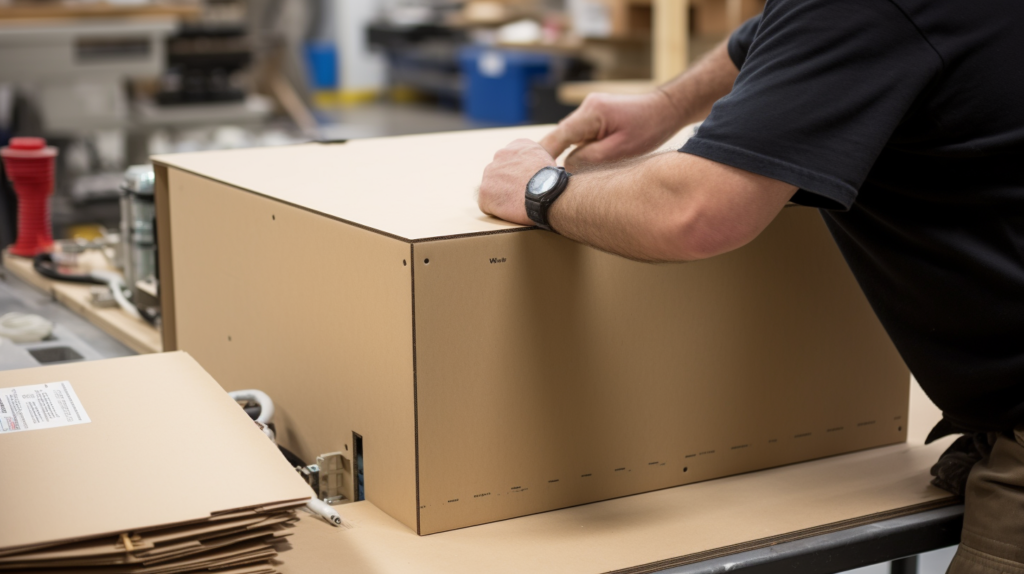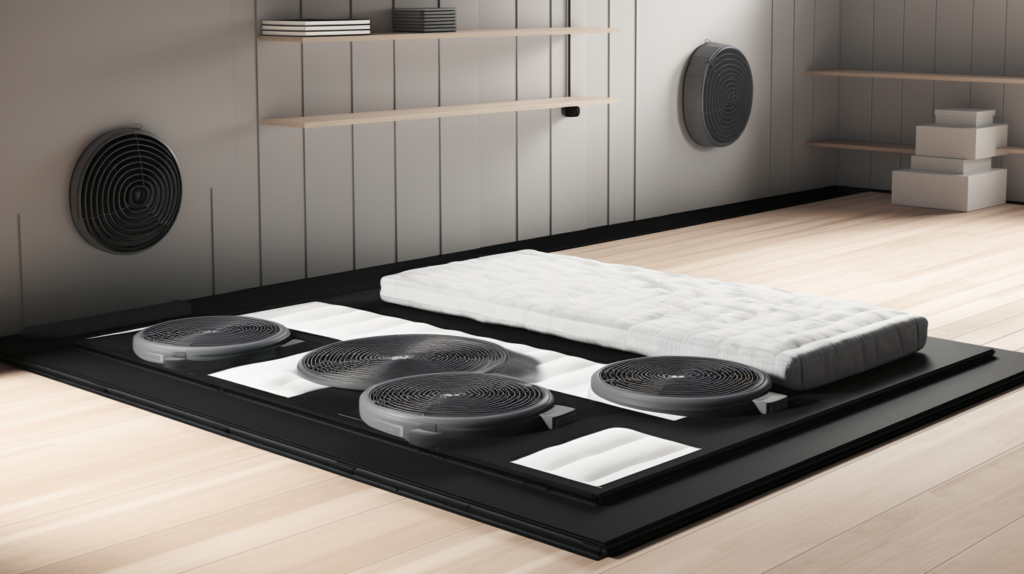Is your portable air conditioner driving you crazy with loud disruptive humming all day and night?
Simple soundproofing techniques can eliminate noise from portable AC units for peaceful quiet operation.
Let’s dive into a step-by-step guide on how to soundproof a portable air conditioner for a noise-free experience.
How to Soundproof a Portable Air Conditioner

Having a portable air conditioner can be incredibly convenient, allowing you to cool spaces without permanent installation.
However, the noise from the compressor and fan can be disruptive, especially when trying to sleep or work.
Fortunately, there are several effective methods to reduce the noise coming from a portable AC unit. With some simple soundproofing materials and techniques, you can muffle the sounds and enjoy peace and quiet.
Benefits of Soundproofing a Portable Air Conditioner

Soundproofing your portable air conditioner provides numerous advantages that make it worthwhile to reduce the noise. Here are some of the top benefits:
Reduces Noise Disturbances for a More Peaceful Environment. The primary reason to soundproof a portable AC is to decrease noise disturbances.
The loud compressor and fan sounds can prevent you from falling asleep, interrupt conversations, disrupt work concentration, and generally create an unpleasant environment.
Muffling these noises allows you to have a more peaceful space.
Allows Use of AC Without Bothering Housemates or Neighbors. Portable air conditioners are very convenient when you want to cool only certain rooms or areas.
However, the noise can spread and bother other people at home or in adjoining apartments or houses. Soundproofing contains the noise so you can run the AC without disturbing others.
Helps You Sleep Better by Eliminating Machine Noise. Trying to sleep near a loudly humming air conditioning unit can be challenging.
The persistent noise can keep you from falling asleep or wake you up frequently. By soundproofing the portable AC, you can eliminate the disruptive machine sounds and sleep better.
Enables Running AC as Needed Without Ambient Noise. Air conditioners sometimes need to be run for many hours straight on hot days to maintain a comfortable temperature.
But having the AC on constantly can create an annoying ambient noise in the background. Soundproofing allows you to run the AC as much as needed without a loud droning sound that never goes away.
1. Add Sound Damping Mat To Your Portable Air Conditioner

The first step in soundproofing a portable air conditioner is to wrap the compressor with acoustic sound damping mat.
The compressor creates vibrations that transmit noise. A sound damping mat absorbs these vibrations and dampens the resulting noise.
Completely wrapping the compressor in this absorption barrier mat will greatly reduce the noise emitted.
When applying the acoustic mat, wrap the entire compressor while leaving a small gap between the mat and compressor.
The mat should not be touching the compressor, because it needs space to deflate the vibrations into the mat material.
But the mat should fully surround the compressor to contain noise in all directions. Just be sure not to wrap the mat so thickly that it blocks ventilation, as the compressor still needs to be able to cool itself.
Using 1/4 to 1/2 inch acoustic mat pads should allow sufficient noise dampening while not inhibiting airflow.
There are a few options for sound damping mat materials. Some good choices are butyl rubber sheets, mass loaded vinyl (MLV), or limp mass barrier mats.
These dense, flexible materials effectively absorb vibrations and reflect minimal noise. Peel and stick acoustic mats make the installation process easy.
Simply cut the mat to size, remove the adhesive backing, and apply to the compressor. The result will be a significant reduction in noise from the compressor vibrations.
2. Build an MDF Cover Shelf For Your Portable Air Conditioner

In addition to damping the compressor vibrations, you also need to contain the overall noise coming from the air conditioning unit.
A simple and effective method for this is building an acoustic cover box from MDF (medium density fiberboard) or plywood.
The basic process is to cut boards to size, seal them into a box shape, and place the portable AC unit inside.
First measure the dimensions of your portable air conditioner. Be sure to account for any exhaust piping and other protrusions.
Cut several MDF or plywood boards to size according to your measurements. The top board can be removable for easier access to the filters and controls.
Seal the edges and joints thoroughly with acoustic caulk to prevent sound leaks. Then assemble the boards into a cover box with the back side open.
Place the air conditioner inside the cover box, securing it if needed to prevent movement.
Adding mass is key to soundproofing, and the MDF or plywood cover will significantly block noise transmission.
The dense wood material does not vibrate like thin plastic or metal, thus containing the noises. Seal any remaining gaps or holes with caulk.
Lining the inside of the cover with acoustic foam (addressed in the next step) will further absorb noise.
Painting the outside of the cover box can provide some additional sound blocking and allows you to match any décor.
3. Line the Inside Of Your MDF Cover Shelf with Foam

Lining the inside walls of the MDF cover box with soundproofing foam is the next step in reducing noise from the portable air conditioner.
This acoustic foam padding will absorb some of the internal noise and prevent echoes that amplify sound.
Choose an acoustic foam made from melamine, polyurethane or polyisocyanurate. Avoid using fiberglass, as it can be hazardous if inhaled, especially when not fully enclosed in drywall.
Measure the interior dimensions of the MDF cover and cut foam panels to size. Polyurethane acoustic foams are readily available with peel-and-stick backing for easier installation.
Firmly press the foam panels onto the interior walls of the cover.
Focus on lining the areas around the compressor and any fan intakes. Fully covering the interior provides the maximum noise reduction.
The foam absorbs some of the noise and prevents it from bouncing around and amplifying sound within the box.
This dual-layer soundproofing approach of the MDF mass barrier and the foam absorption material will significantly muffle the noises.
4. Isolate with Rubber Pads Underneath Your Portable Air Conditioner

Installing isolator pads underneath the portable air conditioner is important to prevent transfer of noise and vibrations into the surrounding surfaces.
When an AC unit sits directly on the floor or a wall, it can transmit vibrations through those structures and create disturbance in adjacent rooms.
Placing dense rubber isolator pads between the AC and floor interrupts this sound transmission path. The pads absorb vibrations and decouple the AC unit from directly contacting the floor.
This breaks the sound bridge. Quality dense rubber pads work best, but cork pads also isolate vibrations effectively.
For window mounted AC units, using isolator mounts between the air conditioner frame and the window frame serves the same purpose.
The isolators prevent the window from amplifying sound transmission. Installing quality rubber mounts reduces noise issues from window mounted ACs.
Proper installation is key for the isolators to work effectively. The AC unit should be securely positioned atop the pads without touching the surrounding surfaces.
Isolator pads come in various thicknesses; using pads rated for the weight of the AC unit ensures adequate support and isolation.
With the AC unit resting on isolators, vibrations get absorbed rather than transferring outwards.
5. Add Exhaust Soundproofing To Your Portable Air Conditioner

The exhaust pipe on portable air conditioners expels the hot air outside, often through a window. This exhaust area can be a significant source of noise as the air rushes out.
Lining the exhaust vent and piping can muffle this fan noise for quieter operation.
First, wrap the exhaust pipe in MLV (mass loaded vinyl) insulation. MLV is a dense, flexible vinyl material containing tiny metal particles.
Wrapping the exhaust pipe in this heavy mass containment vinyl blocks noise from escaping the pipe. Secure the MLV with duct tape or pipe clamps, sealing it entirely around the exhaust pipe.
Next, cut acoustic foam inserts to fit snugly in the end of the exhaust pipe. This acts as a muffler to absorb the noise in the airflow exiting the AC unit.
The foam inserts can be swapped out if they accumulate dirt over time. For window exhaust vents, adding soundproof foam sealing around the edges helps contain noise.
With the exhaust path insulated for sound, fan noise is reduced.
Importantly, be sure not to block the exhaust vent or pipe too extensively when adding the soundproofing materials.
The AC needs sufficient airflow to ventilate properly. The goal is to muffle and contain the noise while maintaining exhaust function.
Adding MLV wrap and foam inserts accomplishes sound reduction without inhibiting ventilation.
6. Reassemble and Enjoy Peace and Quiet

After completing all the soundproofing steps, reassemble the portable air conditioner within its MDF cover box and place it atop the isolator pads wherever positioned.
Seal any remaining small gaps with acoustic caulk or foam strips. Then plug it in, switch it on, and enjoy the clear reduction in noise!
Without proper sound dampening, portable ACs can create loud droning sounds that easily disrupt activities.
But with the simple DIY soundproofing steps detailed here, you can eliminate noise disturbances from the portable air conditioner.
The compressor vibrations get absorbed, the overall noise gets contained, and vibrations are decoupled from transferring outwards.
Your household members, neighbors, or roommates will appreciate the reduced noise.
You’ll be able to comfortably use the AC anytime without bothering others or sacrificing pleasant ambient peace and quiet.
Finally, get some good sleep without that loud compressor humming all night long! Soundproofing your portable air conditioner solves the noise issues and provides a greatly improved environment.
Conclusion
After following these simple steps to soundproof your portable air conditioner, you can finally relax and enjoy a peaceful, quiet environment free of machine noise.
No more loud disruptive humming or disturbing your household. Just ambient peace and quiet on demand with your noise-reduced AC unit.
Get better sleep, increased focus, and happier home life by muffling compressor noise and containing vibrations.
Soundproofing your portable air conditioner provides all the cooling benefits without the noise drawbacks for improved comfort and tranquility.
